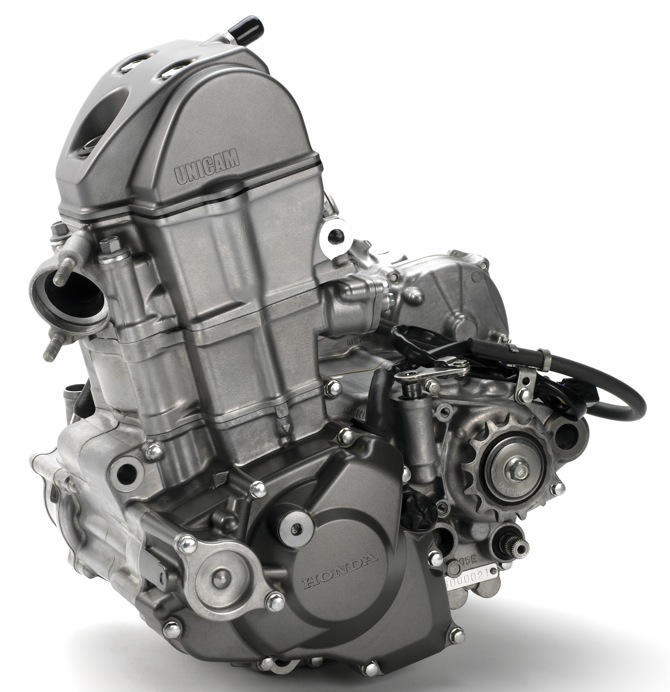THE COMPLETE, EXHAUSTIVE, & DETAILED GUIDE TO THE 2013 CRF450 ? MORE THAN ANYONE ELSE WILL EVER TELL YOU

Deemed the “Ultimate Triangle Proportion” by Honda’s marketing team, the CRF450 has minimal plastics, yet maximum ergonomics. The plastic thickness has been lessened in some areas to decrease weight. The shrouds were designed to flow more air and improve radiator efficiency (note: the radiators are now slightly smaller). The gas tank capacity has been increased from 1.5 gallons to 1.66 gallons. The plastic front disc cover is now attached by two bolts, instead of having the axle collar pressed in.

All-new Unicam engine. The cylinder head with revised porting and larger exhaust valves (from 30mm to 31mm).

Honda aimed at improving low-to-midrange power and torque without sacrificing top-end power in the Unicam engine. They did this by upping the piston compression (from 12.0:1 to 12.5:1), revising the cylinder head design (1mm larger exhaust valve size), new valve timing, adding an additional piston jet (for misting), and using a new intake air boot for optimized air flow.

All-new piston with increased compression ratio (from 12.0:1 to 12.5:1).

New two-hole oil jet adds extra cooling to the piston’s underside.

Realizing that their previous four-spring design wasn’t working, Honda went back to the pre-2009 six-spring clutch design.

The six-spring clutch has eight plates, plus two chatter springs at the end of the pack.

The cam has new valve timing and the exhaust valves at 1mm larger in diameter (from 30mm to 31mm).

More flywheel weight is added to give the engine more chug at low rpm…and less tendency to flame-out or stall.

Honda also redesigned the transmission, revised the electronic fuel injection and ignition settings, and used a heavier flywheel for improved traction and low-end torque.

Honda patented a dual diamond-shape muffler design, and they say that this design offers several advantages: (1) A shorter muffler improves mass centralization, the center of gravity, and creates a lightweight feel to improve cornering and easier side-to-side transition. (2) The twice pipes are said to increase engine performance while still meeting the (old) 94 decibel limit. (3) The dual mufflers have allowed Honda to redesign the subframe. This allows for a straighter air intake and easier filter access. Remember that Honda used a twin-pipe design on the CRF250 for four years (2006-2009).

The exhaust system splits behind the air box. The rear shock mount is 14.5mm lower. The goal was to improve front and rear traction, cornering performance and stability.

Honda’s engineers lowered the junction point of the head pipe and frame tubes to optimize rigidity and lower the center of gravity. Honda still uses their own HPSD steering damper.

Air replaces the main springs, making it easy for a rider to easily adjust the stiffness of the fork by adding or dropping air pressure by way of a Schrader valve on top of the fork cap. Adding or dropping 2 psi equates to a different spring rate.

The air fork is significantly lighter since both main springs have been removed which allows for the incorporation of a larger, more sophisticated 32mm cartridge damper piston that resets traditional thinking for front suspension performance. It’s worth noting that the PSF that comes on the Honda is developed specifically for the CRF450 (meaning that it’s not the exact same fork as what comes on the 2013 KX450F).

Although the CRF450 has the same frame geometry as the previous generation CRF, the mass is lower on the bike and the swingarm is new. It’s no secret that MXA has criticized the CRF450 for its tendency to wiggle, oversteer and headshake. However, Honda’s engineers swore that they improved the bike’s handling traits by making a series of changes that, although they might seem unrelated to handling, do make an impact.

The 2013 CRF450 will have the HPSD steering damper installed.

The 2013 isn’t as light as the 2012. It will be a few months before MXA can put the 2013 CRF450 on our amazingly accurate scale to get the real answer, since that’s how long it will take the manufacturers to release 2013 models. We do know that the CRF450 gained just under two pounds, thanks mostly to the dual mufflers, swingarm and gas tank.

The bare frame shows the lowered twin spars and top shock mount. The new subframe is designed to hold the twin mufflers farther forward on the frame.

The footpeg mounts features a patented debris-shielding design to keep mud from clogging the pegs. Additionally, the bike gets all-new front and rear disc rotor covers. The front tire is a Dunlop MX51, but not the old MX51, but the new MX51FA (in an 80/100-21 size).

The radiators are mounted lower in the chassis when compared to last year’s CRF450.
2013 HONDA TECH BRIEFING: FOUR MINUTES OF TECH TALK




Comments are closed.